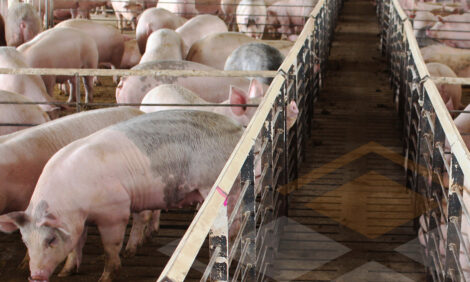



West Nile Virus and the Risk to Pigs
By The Food Safety Consortium - This article is taken from Mays issue of the FSC's Newsletter and looks at the susceptability of pigs to West Nile Disease Kenneth Platt of Iowa State University seeks more information on links between swine and West Nile virus infections. |
Since the emergence of West Nile virus in the Western Hemisphere in 1999, health care personnel have
been on the lookout for signs of infection in people and animals. Recent research suggests that food processing personnel should beware of the presence of the virus in swine and a potential health risk
to employees in pork processing plants.
Food Safety Consortium researchers at Iowa State University examined swine and found that
weanling pigs, about four weeks old, are
susceptible to West Nile virus infection
from a relatively small level of virus
delivered by mosquitoes. The pigs’
susceptibility to the virus appears to
decrease as the pigs grow older, but more
research remains to be done to determine
the risk level of older, marketage
pigs.
Among the younger pigs studied,
levels of the virus in the bloodstream can
be quite high. "There’s enough virus in
that blood that I wouldn’t want to cut
myself with a knife that just went
through there," said Kenneth Platt, an
ISU veterinary microbiology professor
who conducted the study.
It’s also common
among other animals and
birds for the level of virus
concentration to be much
higher in the younger
species than the older
ones. If more extensive
research into market-age
200-pound pigs shows the
virus concentration at
high levels for three or
four days similar to what
is found in the weanlings,
"then I think there should
be concern with
individuals who are
handling those carcasses and that fresh
meat product," Platt said. The next step
would be to examine how long the virus
remains infective in fresh meat and
frozen meat
products.
Infected pigs
can pose a
problem not only
for plant workers
who come in
contact with them,
but can also cause
uninfected
mosquitoes to
contract West Nile virus when they feed
on pigs with the virus in their
bloodstream. Even so, the pigs are still
not a significant source of the virus for
the mosquitoes, Platt said.
Mosquitoes remain the most likely
source to infect pigs when they are
housed together on the farm or at an
abattoir. "In our observations we’e had
infected and uninfected pigs in the same
pen in intimate contact, and we saw no
evidence of transmission from pig to
pig," Platt said. "The most logical
conclusion is that pigs are going to
become infected by the bite of
mosquitoes."
More research on the topic will be
necessary to follow on some of Platt’s
suspicions that the latest research has
narrowed. For example, if a six-monthold
market-age pig has a high level of the
West Nile virus in the bloodstream, the
threat to the processing plant employee
could be exposure by cutting through
infected meat or by
incurring a scratch
from a sharp bone.
"If you pick it
up and handle it
and you don’t have
any scratches on
your hand, I don’t
think that would
be a problem,"
Platt said. "If you
cut yourself on a bone or knife, it could
be a problem. But we don’t really know
yet.
Source: The Food Safety Consortium Newsletter - May 2004







